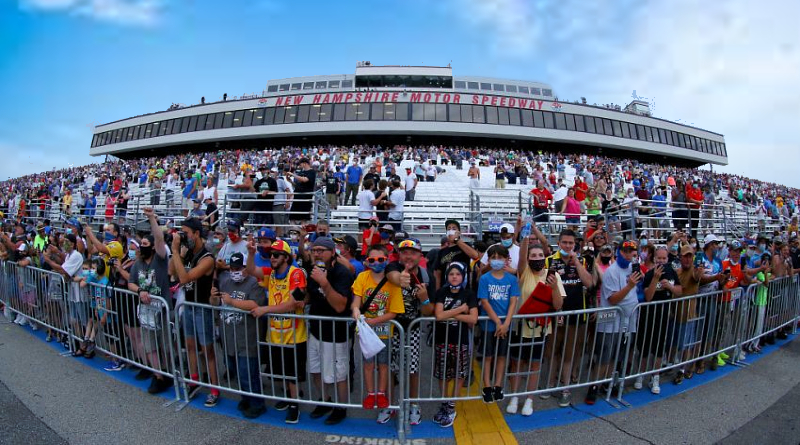by Jerry Bonkowski for NASCAR.com
There are few “together” experiences that can compare to a family’s first time attending a NASCAR race in-person.
No matter if it’s Daytona, Talladega, Bristol or elsewhere, what parents and their kids experience in their first NASCAR race together is likely to be one of the most enjoyable, special and memorable once-in-a-lifetime bonding experiences they can have as a family.
One of the most frequently asked questions we get at NASCAR.com is what kind of tips we have for families attending their first race together to enjoy the experience to its fullest.
As part of NASCAR’s Summer Family Fun initiative, here are 10 helpful tips for a family’s first time at the track:
1. I thought you had them: One of the most important tips of all: Don’t forget your tickets! It’s not unusual that when fans set out en route to the race track that they’re all so excited and anticipating all the fun and new experiences they will have, that tickets are sometimes the last thing that’s remembered. To paraphrase the old American Express commercial, don’t leave home without ‘em. A sub-tip: Put all the tickets in an envelope the night before and safely tuck it away in mom’s purse or the car’s glovebox, some place where you know where to look when it’s time to go through the gates.
2. What’d you say? Let’s face it, race cars are LOUD! And they can definitely impact hearing, particularly for young kids whose hearing is still developing. Simply put, don’t forget ear plugs or headphones. A NASCAR race, particularly on a short track like Bristol where seats are more close up than at other bigger tracks where seating – and sound – is more spread out, can be as loud at times as heavy metal concerts or planes taking off. And speaking of hearing, if you want to add yet another element to your overall race enjoyment, consider renting a scanner to keep up with driver in-car audio and video to get an even closer look at what’s happening.
3. What time does the race start? We can’t emphasize this enough: LEAVE EARLY, EARLY, EARLY! We’ve heard countless stories where folks have left one or two – or even more – hours early to get to a race, only to wind up stuck in traffic and they miss half the race or more! Fortunately over the last decade, virtually every track on the NASCAR circuit, working in conjunction with police and transportation officials, have devised plans for significantly improved ingress and egress. But even with those improvements, don’t think you can leave 30 minutes before the green flag and still make it to your seats in time. Prepare for unexpected delays, from traffic to inclement weather to car trouble like a flat tire or you run out of gas. One other thing as you’re driving to/from the track: be patient in traffic. If you’re not moving or doing so at an agonizing crawl, odds are several thousand others people are in the same boat. And to paraphrase the old saying, what goes up must come down, remember to maintain your patience with traffic leaving the track after the race, too. It can actually take you longer to leave than what it took to arrive.
4. Sun, sun, sun, here comes the sun: Sun can help keep you warm, but can also have a detrimental effect, too. So bring plenty of sunscreen (the higher the SPF, the better) to protect against sunburn, as well as wear sunglasses to greatly cut down on glare and ultraviolet rays that will interfere with your vision and overall enjoyment of the race.
5. Dress the part: Keep checking the weather forecast to find out the latest conditions leading up to race time. Make sure you have the right clothing for the weather, and also the time of day. You can start an afternoon in, say, Texas with a late-afternoon temperature of 85 degrees, and by the time the race gets over several hours later in the evening, temps can easily drop 20 degrees or more. And it never hurts to keep an extra sweater or jacket – and even a change of heavier or lighter clothing – in the car, just in case.
6. Programs, get your programs: There’s an old baseball adage that is equally relevant in watching a NASCAR race, where “you can’t tell the players without a scorecard.” Given that this is your family’s first race together, there’s likely a number of drivers and car numbers in the field that may not look familiar. Programs give great bits of information about the participants and, more importantly, becomes a treasured souvenir for years to come.
7. Mo money, mo money: Attending a NASCAR race can be costly for families with things like food and beverages, souvenirs, parking fees, etc. Those are to be expected. But also be prepared for unexpected costs. Always bring extra money with you, or make sure you have plenty of available cash on your credit/debit card, just in case. One way to save money is to bring food or drinks from home in a cooler. But, make sure to check with respective tracks ahead of time to see if there are any size limitations on coolers or their contents.
8. Be a shoo-in: At some of NASCAR’s biggest tracks, you can EASILY log five miles (and countless blisters) or more of walking while exploring souvenir stands, the midway, or just checking out the sights. We can’t stress this enough: make sure everyone in the family – especially the youngsters – wears very comfortable shoes (even if they’re fashionable or make you look good in them, ladies, that means no high heels. You can thank us later).
9. Oh, my aching (fill in the blank): Sitting for several hours can do a number on your back and butt. Think about bringing along a seat cushion (or buy one at-track). Your anatomy will likely thank you later.
10. Last but not least: A) Even though we’ve turned the corner on COVID-19, it’s still important to remember your face mask and try to maintain social distancing whenever possible, particularly in long lines or close seating quarters. B) If you want to see the action even closer, invest in a good pair of binoculars. C) if you use your cell phone to keep up with the NASCAR.com app or other apps, or watch video or listen to the Motor Racing Network or Performance Racing Network radio broadcasts, those can quickly drain your cell’s battery. Invest in a portable cell battery charger. That way, you’ll likely never run out of juice and can stay on top of things.
We hope you enjoyed our little tip sheet here. But perhaps the biggest tip of all: have F-U-N!

